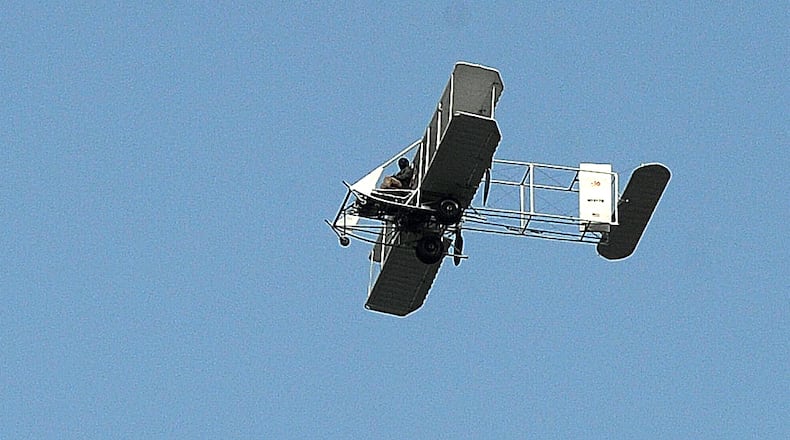“This is the 96th anniversary of the opening of Wright Field when Orville Wright cut the ribbon to open this field,” said Col. Christopher Meeker, commander of the 88th Air Base Wing, Wright-Patterson’s host unit, and installation commander.
The military presence in Dayton stretches back to well before 1927. And world aviation traces its beginnings to the pioneering work of Dayton’s favorite brothers, Wilbur and Orville Wright, who refined early flight above the beaches of Kitty Hawk, N.C. and the grass fields of Huffman Prairie in northwestern Greene County.
But 1927 was a key moment when the federal government took formal control of the land that became today’s Wright-Patterson.
It was land that came courtesy of a gift from the people of Dayton a few years earlier.
“The Dayton community is responsible for the existence of this installation,” Meeker said, speaking at a celebration outside the Wright Patt Club on the base’s Area A.
He called it “the greatest partnership story in the history of the Air Force.”
When Army aviators understood they could no longer operate on crowded McCook Field north of downtown Dayton, local leaders took action to control nearby land to keep military functions local.
“The people of Dayton, just like now when there’s a base realignment and closure activity, they didn’t want to lose that great facility,” said Kevin Rusnak, chief historian for the Air Force Life Cycle Management Center. “So they got together, they bought all this land that Wright Patt is now sitting on, and they donated it to the government.”
The local group raised $400,000 over 48 hours to buy land from the Miami Conservancy District — the area’s multi-county flood control effort — to give to President Calvin Coolidge and the government.
The outcome a century later: An Air Force base that is home to Air Force Materiel Command, which controls a substantial chunk of the annual Air Force budget, the Air Force Research Laboratory, the National Air and Space Intelligence Center, and many other crucial missions.
“We’ve come a long way since then,” Rusnak said.
Thursday was also a day, appropriately, for flying.
Earlier in the day, Meeker and local entrepreneur Larry Connor, managing partner of the Connor Group in Miami Twp., took turns flying figure 8s over Huffman aboard a modern replica of the Wright B Flyer. The flights were arranged by Beavercreek City Council member Don Adams, who is president of the Wright B Flyer Museum, and a National Aviation Heritage Area board member.
“It was really special for me to have this opportunity,” Meeker said.
Partial Wright Patterson Air Force Base timeline
1917: Fairfield Aviation General Supply Depot
1924: Dayton Air Service Committee sells land that becomes today’s Wright-Patterson to U.S. government for $1.
1942-1945: Expansion of Wright and Patterson fields.
1945: West ramp expansion
1948: Formation of Wright-Patterson Air Force Base.
1960: Acquisition of Page Manor housing
1978: Wright Memorial Hill and Huffman Prairie transferred to the Air Force.
About the Author


